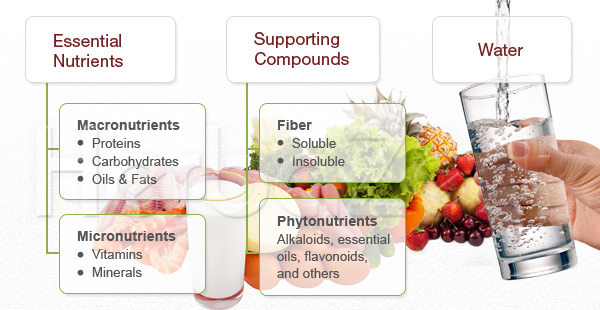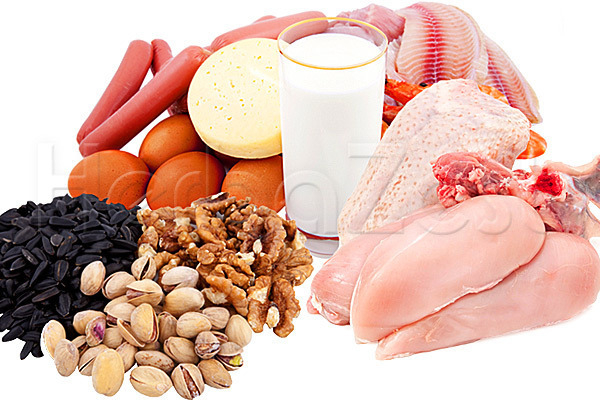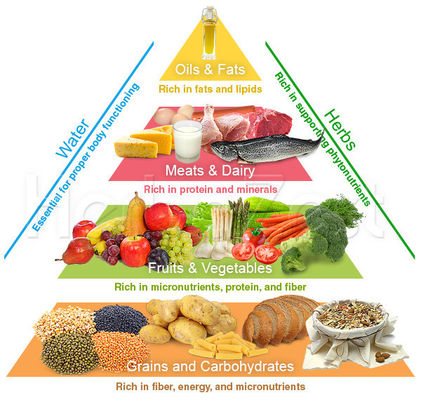Medicine is one of the branches of human knowledge that advances the fastest. Day by day, scientists discover new treatments for a myriad of diseases that were once regarded as insurmountable. However, at the same time, it is hard to escape the fact that many conditions seem to be increasing in prevalence, and that the costs of managing them and their complications continue to rise. The apparent new "epidemic" of many conditions highlights the importance of prevention rather than treatments.

Constant research has indicated that health is directly associated with nutrition and that balancing a diet and eating certain foods may improve health and even provide therapeutic action. One of the keys for preventing many modern diseases - like obesity, arthritis, and heart disease - is to keep a healthy, balanced, and complete nutrition. It is only by feeding the body the right way, and in the right quantities, that overall balance can be achieved.
Nutrients
The body can use many nutrients found in both plant and animal products, though research shows that the human body has been honed to absorb more nutrients from plants than from meat. Some of these nutrients are essential for basic functions, while others further enhance those functions.
The essential nutrients are divided into two categories based on their size: macronutrients and micronutrients. Supporting compounds, while not essential, promote optimal functioning and overall health. Finally, water - though not classified as a nutrient - is a vital substance the body needs to carry out all of its processes. Continue reading for an explanation of the major essential and supporting as well as the food sources in which they are found.

Macronutrients not only assist in bodily functions; they are also necessary for meeting the basic structural and energy requirements of the organs and tissues. The three macronutrients are:

Proteins. They form the basic building blocks for most cells, large compounds, and body tissue, particularly muscles. They can be found in most animal meats, dairy, and certain vegetables like legumes.
Carbohydrates. This is the body's preferred source of quick fuel, and they come in two types: simple carbohydrates or sugar and complex carbohydrates or starches. They are vital for energy and brain function. Whole grains are a rich and healthy source of complex carbohydrates.
Fats and lipids. Although fats are often considered "bad," they are an essential component of cells and play other roles in the body as well, provided they are consumed in moderation. Just like carbohydrates, fats can also be burned for energy, but this requires a lengthier process by the body and thus they tend to be stored. In general, unsaturated fats are healthier than their saturated counterparts. Vegetable oils are rich in unsaturated fats.
On the other hand, micronutrients are crucial for fulfilling many of the body's internal chemical processes and allow for proper organ functioning. The two main types of essential micronutrients are:
Vitamins. These are organic compounds that the body cannot create on its own, but are necessary for organ function and regulation. There are 13 vitamins deemed essential for humans, and each one is commonly identified with a letter.
Minerals. These are chemical elements, and as such, they must come from outside sources. They carry out very different functions around the body: while essential minerals like calcium build bones and joints, other trace elements (or "oligoelements") like chromium are necessary, albeit in very minor quantities, to regulate the metabolism of fats and carbohydrates.
Supporting compounds enhance how the body works and help it function at is maximum potential. There are two important ones to consider: fiber and phytonutrients.
Fiber. Fiber helps to regulate the digestive tract and make digestion smooth. The two types of fiber, soluble and insoluble, regulate the digestive system to make it as efficient as possible. Fortunately, many plant sources contain both types of fiber.
Phytonutrients. These are unique micronutrients found in certain herbs. Many beneficial plant compounds, including flavonoids, phenols, and terpenes, are often overlooked, and thus many bodily functions may stop working at their best potential. Although this will most likely not cause illness directly, they can play a role in the onset of memory problems, constant fatigue, or premature aging.
A proper combination of all these elements will allow the perfect and harmonious functioning of all the different body functions.
Nutritional Balance and Health

In general, each macro- and micronutrient has its own recommended daily value. For example, the suggested daily intake of calcium is 1,000 mg, but this amount varies based on age, gender, and individual needs. It is important to meet this daily value, since a long-term calcium deficiency greatly increases the risk of osteoporosis.
In all areas, moderation is key. Many of the pains and ailments people experience frequently can both micronutrient deficiencies and overeating, with many experiencing both at the same time. Furthermore, certain long-term imbalances also raise the risk of serious diseases, and other people who do not experience obvious, uncomfortable symptoms from nutritional imbalances may be compromising their health and wellbeing nonetheless.
Even seemingly small deficiencies, especially in micronutrients, can cause imbalances in the endocrine system, lower the strength of the immune system, or even cause constant digestive problems. Because people suffering from slightly elevated levels of cortisol, or who are prone to catching constant colds, are not "sick" in a traditional sense, many people don't realize their body is not functioning as well as it could until they modify their eating habits.

Supporting nutrients, found predominantly in herbs, can complement good health and help in the prevention of diseases. Many of the unique compounds certain herbs contain can make body processes more efficient, reducing wear and tear and extra energy expenditure. For example, hundreds of years of empirical evidence have shown that garlic can help reduce high blood pressure and lower cholesterol, and modern research has corroborated this claim and has also identified the unique amino acids responsible. Thus, by adding more supporting phytonutrients to one's diet, it is possible to prevent or manage many conditions.
Importance of Balance
The generally recommended ratio of macronutrients is 50% carbohydrates, 30% proteins, 20% fats. Like with any daily value, however, these proportions vary based on age, gender, and personal factors. For example, women in menopause should shift this ratio to 40% carbohydrates, 35% proteins, and 25% fats to compensate for changes in metabolism and body chemistry. A doctor or dietician can always help any individual calculate their optimum intake values for each macro- and micronutrient.
A balanced diet that includes all the essential nutrients in addition to as many supporting nutrients as possible helps to ward off conditions, maintain a healthy weight, and improve overall functioning of the body's systems. Based on the well-known USDA food group pyramid, the HerbaZest Nutritional Pyramid combines major food groups with supporting phytonutrients and water. While a balance between the food groups provides all the essential micro- and macronutrients, the inclusion of herbal phytonutrients provides overall support for the good health achieved through a balanced diet.

With the HerbaZest Herbal Encyclopedia, we aim to provide you with the necessary tools and knowledge to balance your nutrition and achieve the best possible health. We have compiled extensive information on medicinal remedies and nutritious herbs, their means of consumption, and their nutritional and economic value. Through a balance of essential nutrients complemented with herbal supplements, the body can work its best day after day, providing the nutrition you need to live your life in the best of health and wellness.
